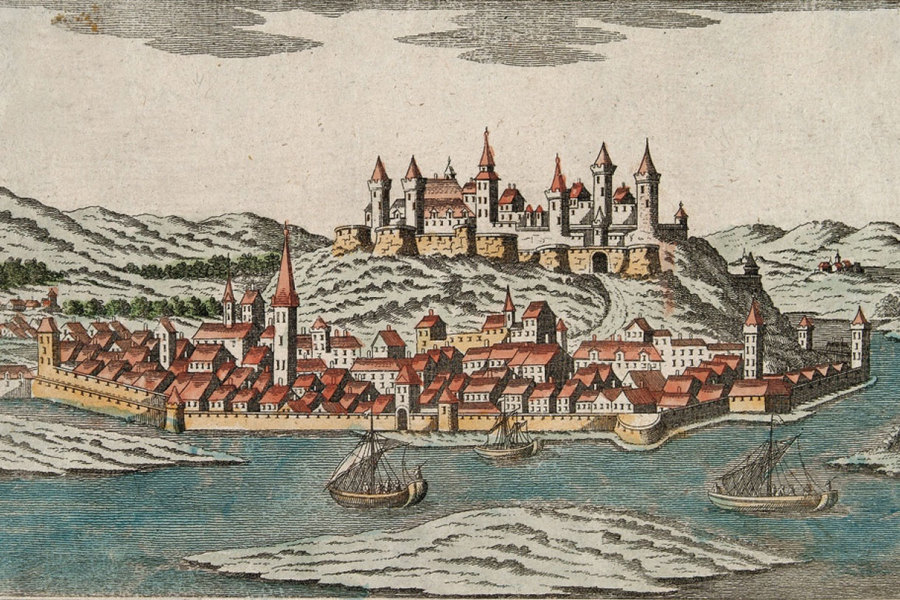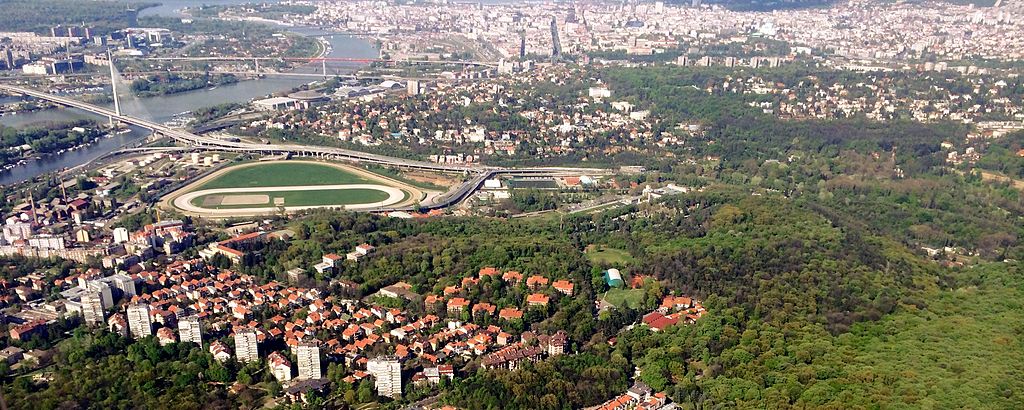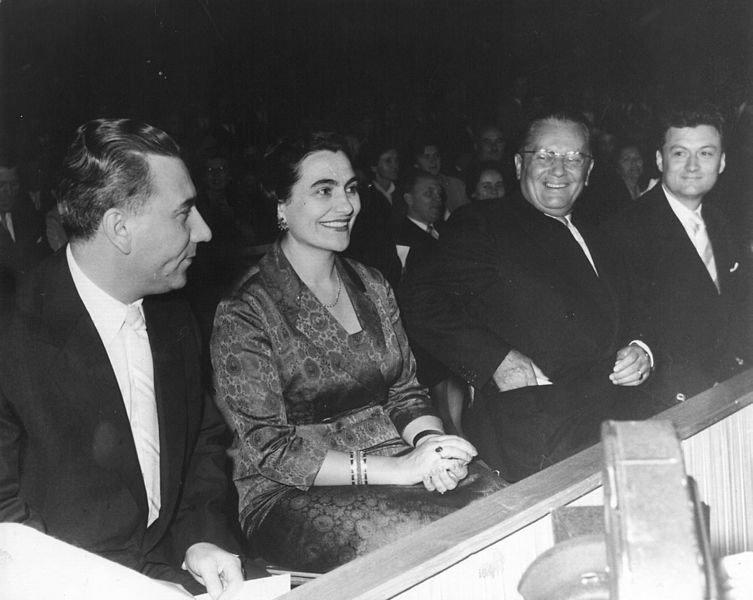
Photo: Muzej grada Beograda
Belgrade, the city atop 31 hills
“The Serbs built their house on a road”, were the words of the famous Serbian geographer Jovan Cvijic. Still, when it comes to Belgrade, Serbs mostly built houses on hills. 31 of them, to be exact. This gave the citizens a strategic advantage in case of war, but also cleaner air in peaceful times.
Today, Belgrade has grown and ‘occupied’ many hills that got their names through a mixture of imagination and reality.
This is a story on how the hills which have carried the history of Serbia’s capitol got their names.
When the birds are an inspiration
As soon as you enter Belgrade, at about 205 altitude, you will find Petlovo hill. The denizens of this settlement believe that it got its name after an unknown rooster (Petlovo = Rooster’s). There are also those who say that the rooster in question was up to three times the size of a regular rooster and had a majestic crest. Thanks to his size he was, allegedly, the ruler of this settlement in his lifetime and walked around freely because nobody dared approach him. Sadly, there is no official confirmation for this version of events.
Another bird inspired the name of Labudovo hill (Swan’s hill), a newer settlement in Belgrade. While some think that the name comes from the prominent skyscrapers which resemble these beautiful birds, others say that the architect Aleksandar Djokic coined the name. Namely, Djokic led his project under codename ‘Labud’, so it is believed that in time the settlement simply adopted this name.

Distinguished Serb Ban
The space above Makis which was called ‘Repisko hill’ in Austrian maps from the beginning of the 19th century and later Ordija and Golo hill, was named at the start of the 20th century after one Matija Ban. A Serbian man born in 1818 in Petrovo village next to Dubrovnik.
Matija moved to Belgrade and in 1861 requested from the city the permission to buy land away from the city in order to build a summer house.
However, seeing how Matija worked not only in literary pursuits but also in confidential affairs for the Serbian government, the city officials decided to gift him this land. At first, that entire area was named ‘Banovac’, and after Ban died the name was changed to Banovo (Ban’s) hill.
Brave granny Jula
In Julino hill (Jula’s hill), there are 15 skyscrapers proudly standing. She was a great patriot and during every Turkish attack she would help the resistance. One night – according to legend – the Turks suddenly attacked the Serbian army. Seeing that the situation was dire, Baba Jula and several members of the uprising set fire to some large logs of wood and pushed them down the slope. The rolling fires disrupted and confused the Turks, which gave the resistance enough time to pull their forces together and defend against the attack. Afterwards, the entire hill was named after this heroine.
First railway colony
Kanarevo hill (once known as Goljina hill) began to take on its appearance from today between two world wars. In the “Detailed urban plan for Kosutnjak and Dedinje” from 1984. it is written that “Kanarevo hill is the terrain in which a true railway colony was constructed in the third decade of our century”. It is located on the periphery of the estate of Djordje Kanara, a landlord for whom the Kanarevo hill was named.
On the other sides – North and North-East – the terrain was naturally lined by the railway Belgrade-Pozarevac (and the steep slope towards Dedinje). Up until the Railway colony was built, this area was completely uninhabited. With the urban project from the middle of the 20’s, this colony also had the middle traffic avenue (Pere Velimirovica street) as its public center. The Parcels are approximately equal and they represent the family buildings – villas in the center of a big space ideal for rest and relaxation.
After WWII the outline for the ‘garden city’ was destroyed in favor of constructing new buildings and skyscrapers.

Where the Romans burned their dead
The famous Banjica with its 198m was drawn into the map as a hill. Rista Nikolic, in his book “Okolina Beograda” from 1903 states that “it was known for example that Banjica hill was the place where the Romans burned their dead in III century A.D.”
The settlement was named after a stream running next to it. Near the water the temperature was always a few degrees lower than in the center of the city, and that’s where the name Banjica (little spa) came from.
Dedinberg – a hill for the wealthy
In geography maps from the 18th century, Dedinje is known as ‘Dedinberg’ – Dedinje hill. In 1789, there was an Austrian camp there. In the meanwhile, it was given the shorter name – Dedinje.
The name “Dedinje” more than likely originates from the term ‘dede’ which back in the day was used to call any kind of Turkish official or guard. In this hill, as shown by a Turkish records from 1560, one of the Belgrade ‘tekijas’ (a Muslim monastery inhabited by dervishes), had its own vineyards. Around the end of the 19th and start of the 20th century, there were still orchards and vineyards here, but no significant settlements.
Dedinje owes the reputation it has today to king Aleksandar Karadjordjevic who decided to build his castle in this area, which had previously been almost uninhabited.
Before WWII, this is where influential tradesmen, politician and ministers built their homes and vacation houses.
This gave the hill its reputation of a wealthy neighborhood which remains today.
Valley of cannons
Topcider is the place where you will find one of the most beautiful Belgrade parks, the river Topciderka and the beautiful home of prince Milos. Its name is a portmanteau of the words ‘tobdzija’ and ‘dere’ (valley). The written historical data also states that the Turks in 1521 used this area to cast their attack canons and that’s how the hill got its name.
The arrangement of Topcider is attributed to prince Milos who issued an order on 24th of February 1831, stating:
“Make sure to work with Captain Stankovic to make quality repairs along and across Topcider, wherever there is water damage or any other kind. Don’t let any type of vehicle run across Topcider and deface its meadows. You will make sure that there are several masons producing lime because I have plans for some buildings in Topcider.”
And so it happened. Between the years 1831 and 1834, prince Milos built himself a home in Topcider. This construction also engaged prison inmates as workforce. This is confirmed in a document from 29th of May 1863, in which Nikola Hristic, then minister of internal affairs, reported to prince Mihailo about an event that occurred in Topcider:
“My lord, tonight 5 inmates who were stationed as guards outside of Topcider escaped. The gendarmes on horseback found one next to the tree in Sava and opened fire, but he opened fire as well and then hid somewhere. It’s not known where they escaped...”

Marshall’s best man and cowardly pasha
Leka’s hill – once known as Pasha’s hill – was named after the Communist official and folk hero Aleksandar Rankovic known as Leka. Rankovic was also the best man at Tito’s wedding.
There’s a lot of information about Pashino hill. It got its name in 1807, during the First Serbian uprising, and after the assassination of the Belgrade vizier to Suleiman pasha. Namely, when the pasha was leaving Belgrade, he wanted to throw his pursuers off trail. This is why he decided to take the Kragujevacki road instead of the Carigradski road.
However, the resistance members were favored by luck. Karadjordje’s soldiers saw through his intentions and intercepted him at the nearby spring. This is how Suleiman pasha and his followers met their end and the hill was named Pasino (Pasha’s) hill.
Later, madam Menka Veljkovic wrote about the boulevard of Vojvode Stepe in her book “Addons for knowing the cities in our country”, published in Belgrade 1931, said that the construction of the Vojvode Stepe settlement in Pashino hill would start in 1922:
“The houses are small and without stories, built with weak materials and mostly by non-experts and without any plans. They were constructed in a rush and they will evidently soon be replaced by large buildings when this settlement becomes an integral part of Belgrade. The residents are workers, office workers, craftsmen and traders. There are many grocery stores, bakeries and other shops...”
After WWII, the name of the hill was changed to Lekino, because Leka Rankovic lived here illegally before the wars and at the start of the occupation in 1941, hiding there until he was arrested in July that same year.
In honor of “Black Djordje”
The settlement and the hill of Vozdovac itself were given this name to honor the leader of the First Serbian uprising, Djordje Petrovic Karadjordje in 1904. It was from this location that Karadjordje and his men started liberating the town and Belgrade fort in 1806.
At first, the neighborhood was named Vozd’s town and later it was renamed Vozdovac, as it’s known today. After WWII the area was called VI region and included both Lekino brdo and Vozdovac.
Unknown namesakes
The name origins of many Belgrade hills have been lost to time. Still, this does not mean that their denizens love their area any less.
This is the case of Milicevo hill located between Visnjica and Slanci. It is mentioned in the book by Rista Nikolic published in 1903, which mentions the name, but no other data.
Mitrovo and Glumcevo hills also have names whose origins are unknown. The reason for this is probably that they were inhabited in a relatively newer age.
In a map of Belgrade from 1925, it was written that Stojcino hill is located somewhere halfway between Konjarnik towards Mali Mokri Lug. However who this Stojca was has yet to be revealed. This is also the case with Orlovo, Curetovo, Malesko, Vodicko, Starac Vasino, Lisasto, Moracko, Erino, Nikino, Stanovacko, Lozovicko, Golo, Belo, Veliko, Zuto, Vracarsko and Zvezdarsko hill.
Over the centuries Belgrade has continued to expand. It is only a matter of time when we’ll inhabit new hills and name them for the future. Because after all, nomen est omen.




 1 ℃
1 ℃




